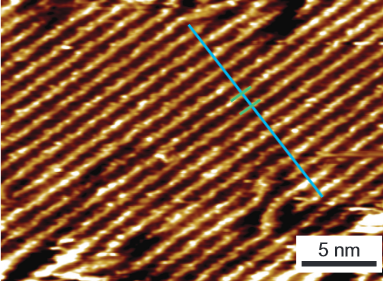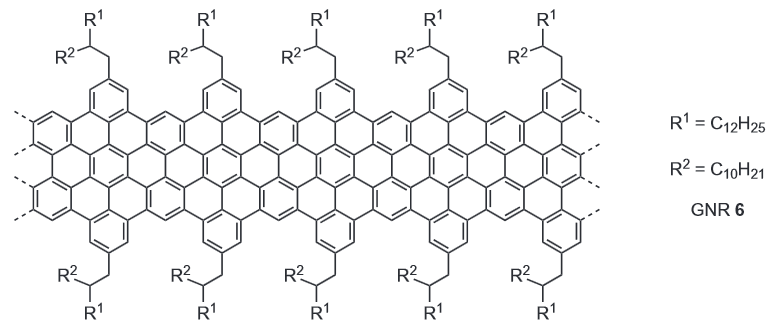Graphene nanoribbons with semiconducting properties synthesized
Could be used in transistors and solar cells; "far more effective than silicon"
December 19, 2013
[+]
STM image of graphene nanoribbons demonstrates a well-organized, self-assembled monolayer of straight and uniform nanoribbons (credit: Nature Chemistry)
Max Planck Institute for Polymer Research
(MPI-P) researchers have succeeded in producing long, structurally
well-defined graphene nanoribbons (GNRs) with semiconducting properties.
STM image of graphene nanoribbons demonstrates a well-organized, self-assembled monolayer of straight and uniform nanoribbons (credit: Nature Chemistry)
The “bottom-up” graphene synthesis method used consists in putting together molecular graphene building blocks to produce graphene nanoribbons in the desired shape and size.
Unlike native graphene, graphene nanoribbons have electronic bandgaps, which allow for control of the movement of electrons and optical properties. They could be used in electronic devices such as transistors and could be far more effective than the silicon currently in use, the researchers suggest.
“Fabrication
of GNRs has been carried out primarily by ‘top-down’ approaches, such
as lithographical patterning of graphene and unzipping of carbon
nanotubes, to reveal their semiconducting nature and excellent transport
properties,” the researchers state in Nature Chemistry.
“However, these methods are generally limited by low yields and lack of
structural precision, which leads to GNRs with uncontrolled edge
structures.”
[+]
“The liquid-phase-processable graphene nanoribbons might also be
applicable in solar cells,” MPI-P Prof. Dr. Xingliang Feng told
KurzweilAI.
Molecular structure of graphene nanoribbon (credit: Nature Chemistry)
“The ‘bottom-up’ chemical synthetic approach employed in this work enables the fabrication of structurally well-defined GNRs in contrast to ‘top-down’ methods, which cannot precisely control the edge structure of the resulting GNRs,” he said.
“The solution-mediated method developed in this innovation allows scalable synthesis of GNRs that are long (>200 nm) and processable from a liquid phase in contrast to the previously reported solution-synthesized GNRs, which were either short (<50 and="" nm="" or="" p="" structurally="" undefined="" unprocessable.=""> No information on possible future implementation in commercial fab processes was available from MPI-P.
The European Commission has a budget of nearly €1 billion over the next ten years for its “Graphene Flagship” research program.
Abstract of Nature Chemistry paper
The properties of graphene nanoribbons (GNRs) make them good candidates for next-generation electronic materials. Whereas ‘top-down’ methods, such as the lithographical patterning of graphene and the unzipping of carbon nanotubes, give mixtures of different GNRs, structurally well-defined GNRs can be made using a ‘bottom-up’ organic synthesis approach through solution-mediated or surface-assisted cyclodehydrogenation reactions. Specifically, non-planar polyphenylene precursors were first ‘built up’ from small molecules, and then ‘graphitized’ and ‘planarized’ to yield GNRs. However, fabrication of processable and longitudinally well-extended GNRs has remained a major challenge. Here we report a bottom-up solution synthesis of long (>200 nm) liquid-phase-processable GNRs with a well-defined structure and a large optical bandgap of 1.88 eV. Self-assembled monolayers of GNRs can be observed by scanning probe microscopy, and non-contact time-resolved terahertz conductivity measurements reveal excellent charge-carrier mobility within individual GNRs. Such structurally well-defined GNRs may prove useful for fundamental studies of graphene nanostructures, as well as the development of GNR-based nanoelectronics.
(¯`*• Global Source and/or more resources at http://goo.gl/zvSV7 │ www.Future-Observatory.blogspot.com and on LinkeIn Group's "Becoming Aware of the Futures" at http://goo.gl/8qKBbK │ @SciCzar │ Point of Contact: www.linkedin.com/in/AndresAgostini
 Washington
Washington